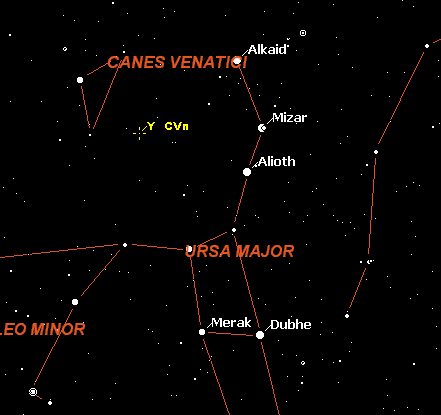| Red
Semiregular Variable Carbon Star
aka HR 4846, HD 110914, SAO 44317, PPM 53169, HIP 62223, BD +46 01817, GC 17342, TYC 03459-2147 1, GSC 03459-2147 Integrated Visual Magnitude: 4.87 B-V color index: 2.54 Spectral Type: C7I Distance ~700 ly |
This star is of interest because of its deep red color. If you have never seen a truly red star in the telescope, this one should be a real treat. Father Secchi is said to have referred to is as "La Superba."
On my 18-inch f/4.5 Y CVn appeared as a deep, fiery orange with a tinge of yellow. The orange was so deep that I was tempted to call it "dark!"
Why is this star red? Stars emit radiation all across the spectrum, from the radio to gamma regions. But the amount of radiation produced peaks somewhere in the middle, usually near the optical region (the small range of wavelengths that our eyes are sensitive to). Exactly where this peak lies depends on the temperature of the surface of the star. Very hot stars peak closer to the blue and cooler stars peak closer to the red. So a very red star like Y CVn is a very cool star.
Usually a star is so hot that it contains only atoms -- molecules are disassociated as soon as they form. But if a star becomes cool enough molecules will appear. In this case molecules of carbon abound in the outer atmosphere. These carbon molecules readily absorb blue and ultraviolet light, leaving the star to appear even redder.

The finder chart above shows the location of Y CVn between the handle of the Big Dipper and Cor Coroli in Canes Venatici.
| Millennium
Star Atlas Vol II Chart 591
Sky Atlas 2000 Chart 7 Uranometria 2000 Vol I Chart 75 |